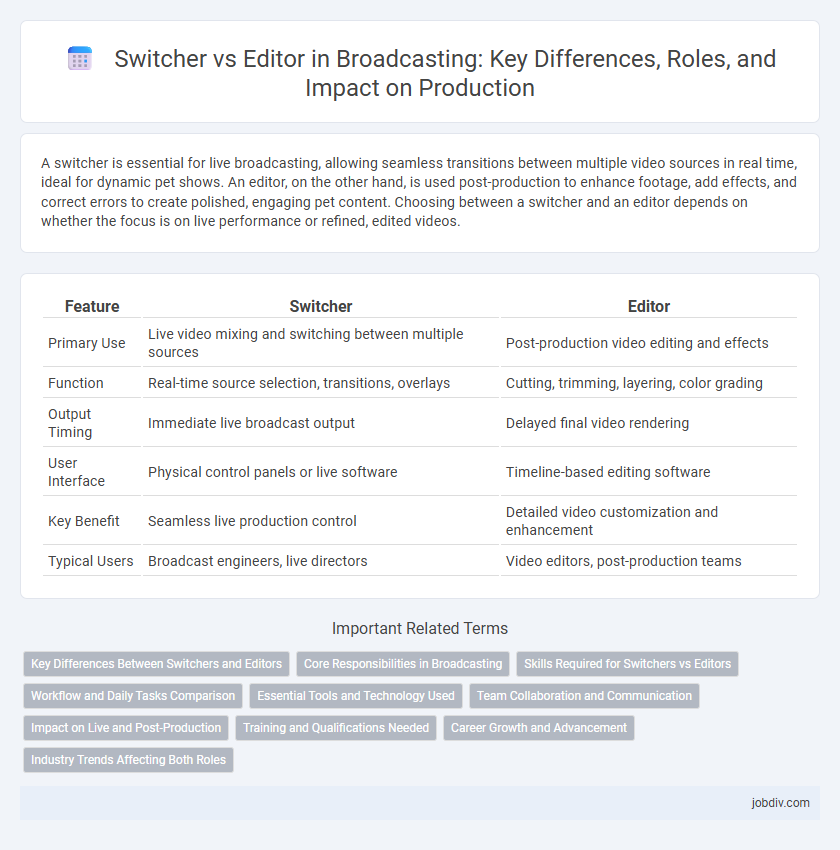A switcher is essential for live broadcasting, allowing seamless transitions between multiple video sources in real time, ideal for dynamic pet shows. An editor, on the other hand, is used post-production to enhance footage, add effects, and correct errors to create polished, engaging pet content. Choosing between a switcher and an editor depends on whether the focus is on live performance or refined, edited videos.
Table of Comparison
| Feature | Switcher | Editor |
|---|---|---|
| Primary Use | Live video mixing and switching between multiple sources | Post-production video editing and effects |
| Function | Real-time source selection, transitions, overlays | Cutting, trimming, layering, color grading |
| Output Timing | Immediate live broadcast output | Delayed final video rendering |
| User Interface | Physical control panels or live software | Timeline-based editing software |
| Key Benefit | Seamless live production control | Detailed video customization and enhancement |
| Typical Users | Broadcast engineers, live directors | Video editors, post-production teams |
Key Differences Between Switchers and Editors
Switcher systems enable real-time video mixing and live switching between multiple camera feeds during broadcasts, ensuring seamless transitions and immediate content delivery. Editors operate post-production by assembling, cutting, and enhancing recorded footage with detailed effects and corrections to create polished final videos. The primary difference lies in switchers' live operational control versus editors' detailed, non-live content refinement.
Core Responsibilities in Broadcasting
A switcher in broadcasting primarily manages live video feeds, seamlessly selecting and transitioning between camera angles, graphics, and video sources during a live production. The editor focuses on post-production tasks, refining recorded footage by cutting, adding effects, and enhancing audio quality to create a polished final product. Both roles are essential in delivering professional and engaging broadcast content.
Skills Required for Switchers vs Editors
Switchers require proficiency in real-time decision-making, multi-camera coordination, and live content management to seamlessly transition between video sources during broadcasts. Editors need advanced skills in non-linear editing software, color grading, and sound design for post-production refinement of recorded footage. Both roles demand a keen eye for visual storytelling but differ in immediacy and technical tools used.
Workflow and Daily Tasks Comparison
A switcher streamlines live broadcast workflows by allowing real-time video source selection, transitions, and overlay management directly during production, optimizing multitasking for live events. Editors focus on post-production tasks, enhancing footage through cuts, color correction, and effects to refine the narrative before final broadcast or distribution. Workflow efficiency in broadcasting depends on seamless integration between switchers' live controls and editors' detailed content polishing.
Essential Tools and Technology Used
Switchers utilize video mixing technology and hardware control panels to seamlessly switch between multiple live camera feeds, supporting real-time visual effects and transitions essential for live broadcasting. Editors rely on non-linear video editing software, such as Adobe Premiere Pro or Final Cut Pro, to manipulate footage with precision, incorporating color correction, audio layering, and multi-track timelines for post-production. Both tools are integral to broadcasting, with switchers optimized for live video production and editors focused on refining recorded content.
Team Collaboration and Communication
Switchers streamline live production by enabling real-time source selection and seamless transitions, facilitating immediate communication among crew members to coordinate live shots effectively. Editors focus on post-production precision, allowing teams to collaboratively refine footage, add effects, and synchronize audio with visuals for a polished final product. Both tools enhance team collaboration but cater to different stages of the broadcasting workflow, maximizing efficiency and creative input.
Impact on Live and Post-Production
Switchers directly influence live production by enabling real-time video mixing, transitions, and effects, ensuring seamless broadcast delivery without delays. Editors impact post-production workflows by enhancing recorded footage with detailed adjustments, color correction, and multi-layer editing to produce polished final content. The synergy between switchers and editors optimizes overall broadcast quality, balancing immediate live engagement with refined post-event enhancements.
Training and Qualifications Needed
Switchers in broadcasting require hands-on training in live production techniques, signal routing, and real-time decision-making, often gained through technical certification programs or on-the-job experience. Editors need proficiency in video editing software such as Adobe Premiere Pro or Avid Media Composer and strong storytelling skills, typically developed through formal media training or specialized coursework. Both roles demand a deep understanding of broadcast standards, attention to detail, and the ability to work under pressure in fast-paced environments.
Career Growth and Advancement
Careers in broadcasting often distinguish between switchers and editors based on skill sets and advancement opportunities. Switchers specialize in live production control, mastering real-time decision-making and multi-camera coordination, which opens pathways to roles like technical director or broadcast producer. Editors focus on post-production, enhancing storytelling through video and audio editing, with career growth leading to senior editors or creative directors in content development.
Industry Trends Affecting Both Roles
The broadcasting industry is rapidly evolving with the integration of advanced technologies like cloud-based production and AI-driven automation, affecting both switchers and editors by demanding faster, more efficient real-time content handling and post-production processes. Switchers are experiencing a shift towards multi-platform live streaming capabilities, requiring enhanced adaptability to manage complex live feeds and overlays. Editors face increasing pressure to deliver high-quality, on-demand content optimized for diverse viewing devices, emphasizing seamless collaboration tools and AI-assisted editing workflows.
Switcher vs Editor Infographic

 jobdiv.com
jobdiv.com